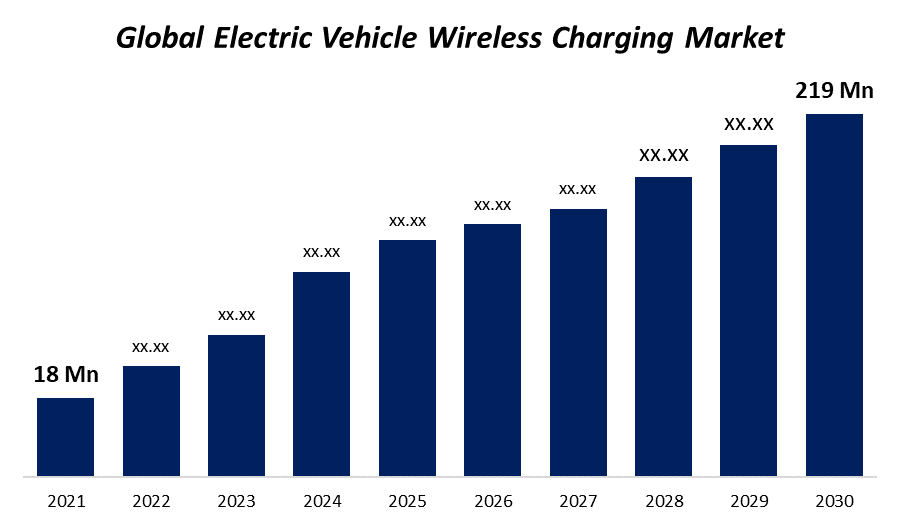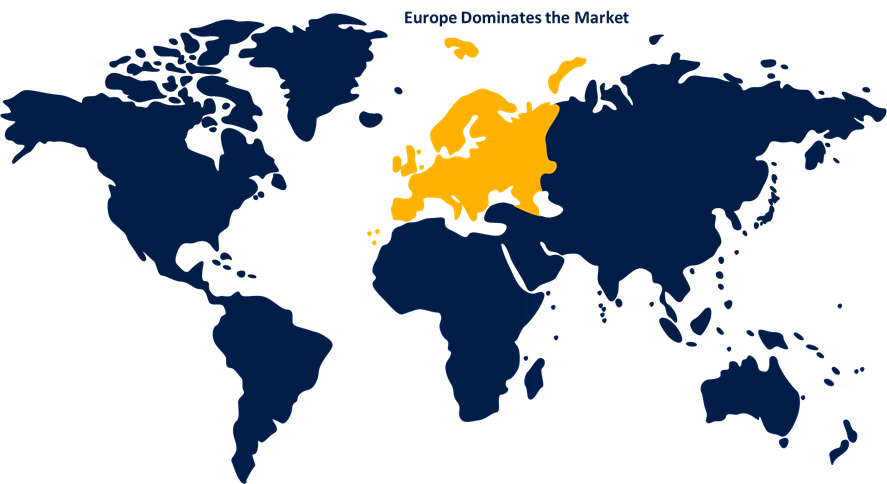Global Electric Vehicle Wireless Charging Market Size, Share, and COVID-19 Impact Analysis, By Type (Static, Dynamic) By Technology (CWEVS, PMWEVCS, IWEVCS, RIWEVCS) By Application (Commercial, Residential) By Region (North America, Europe, Asia Pacific, Middle East & Africa, and South America) – Market Size & Forecasting To 2030
Industry: Automotive & TransportationGlobal Electric Vehicle Wireless Charging Market Insights Forecasts to 2030
The global electric vehicle wireless charging market size was valued at $18 million in 2021 and is expected to reach $219 million in 2030 at a CAGR of 41% from 2021 to 2030. The idea of wireless charging for electric vehicles is based on the inductive coupling theory, in which energy is transferred through an electric device and used to charge batteries. This technique requires a charging base station where two objects may transfer energy in order for it to work. The increased demand for wireless electric vehicle charging systems has been influenced by the increase in demand for electric automobiles. Future market demand is anticipated to increase due to the increased demand for electric vehicles and growing awareness of sustainable transportation options.

Get more details on this report -
The key factors propelling the growth of the wireless electric vehicle (EV) charging systems market are the rising demand for fast-charging infrastructure for EVs, the expansion of wireless charging infrastructure in European nations, the prevalence of range anxiety, and the standardisation of wireless EV charging systems. Major retail MNCs and shared mobility operators throughout the world are projected to deploy autonomous vehicles more frequently in public transportation and logistics in the upcoming years, creating considerable growth potential for market participants. During the anticipated time, a number of market factors, including the rise in demand for electric vehicles and the adoption of better technology to create effective electric vehicle charging solutions, might make the wireless electric vehicle charging market more alluring.
Driving Factors
Due to their effectiveness and environmental friendliness, electric vehicles are becoming more and more popular, which has increased the need for fast-charging infrastructure. Electric vehicles are anticipated to be used for both long-distance and city commuting. However, the majority of EVs on the market today do not have a range of more than 100 miles, necessitating the use of quick-charging technologies to guarantee smooth, uninterrupted driving. Since wireless charging can deliver up to 11 kilowatts of power, which is comparable to level-2 chargers, it offers a viable solution for the expanding, rapidly changing charging requirements. Many wireless technology companies are investing heavily in the research and development of fast-charging wireless power transmission technologies for electric vehicles, including WiTricity Corporation, Momentum Wireless Power, and Wave Inc.
Restraining Factors
High expenditures associated with R&D activities and energy loss during transmission are the main market inhibitors. For businesses to effectively compete in the market, these constraints must be overcome.
Covid 19 Impact
The number of electric vehicles operating on the road (OTR) worldwide surpassed 2 million in 2019. However, the COVID-19 crisis resulted in global industrial closures, constraints on operations and manpower, and disruptions in supply chains. Vehicle sales were drastically down, particularly in the market for electric vehicles, as a result of the economic slump. Significant changes have been made to the demand for electric vehicle charging infrastructure. Since the majority of EVSE (Electric Vehicle Supply Equipment) manufacturers globally have been impacted by government restrictions and statewide lockdowns, significant expenditures for the deployment of EV charging infrastructure have been put on hold.
However, in order to promote economic recovery, the majority of governments in afflicted regions have turned to infrastructure reconstruction. Many governments are making investments in the infrastructure for charging, either directly via the construction of public charging stations or indirectly through the provision of subsidies for the installation of private charging stations at residences and workplaces. Additionally, wireless EV charging systems may be a cost-effective and practical way to meet fleet charging needs. Because electric buses don't produce tailpipe emissions, governments throughout the world are anticipated to give the adoption of electric buses higher priority once COVID-19 is completed.
Global Electric Vehicle Wireless Charging Market Report Coverage
| Report Coverage | Details |
|---|---|
| Base Year: | 2021 |
| Market Size in 2021: | $18 Million |
| Forecast Period: | 2021-2030 |
| Forecast Period CAGR 2021-2030 : | 41% |
| 2030 Value Projection: | $219 Million |
| Historical Data for: | 2017-2020 |
| No. of Pages: | 249 |
| Tables, Charts & Figures: | 123 |
| Segments covered: | By Type, By Application, By Region, COVID-19 Impact Analysis |
| Companies covered:: | Plugless Power, HEVO Power, Qualcomm, Inc., BMW, ZTE Corporation |
| Pitfalls & Challenges: | Due to the increasing number of COVID-19 cases |
Get more details on this report -
Segmentation
The global electric vehicle wireless charging market is segmented into Type, Application, Technology, and Region.
Global Electric Wireless Charging Market, By Type
The market for wireless electric vehicle (EV) charging systems is primarily segmented into static and dynamic wireless EV charging systems based on type. During the forecast period, the segment for static wireless EV charging systems is anticipated to grow at the greatest CAGR. Leading shared mobility and taxi fleet operators around the world are increasingly adopting static wireless EV chargers for fleet charging applications, and there are numerous pilot projects being conducted by top automobile OEMs to integrate these chargers into their electric vehicles.
Global Electric Wireless Charging Market, By Application
The wireless electric vehicle (EV) charging systems market is segmented into commercial and residential wireless EV charging systems based on the application. The market segment expected to see the greatest CAGR throughout the projection period is commercial wireless EV charging systems. Because middle-class and lower-middle-class people in Europe are increasingly purchasing electric vehicles without having the option to charge them at home, there is a high demand for commercial wireless EV charging systems in China due to the availability of large commercial garage parking spaces. These factors, as well as the high proliferation of commercial wireless EV charging systems, are all contributing to the high growth of this segment.
Global Electric Wireless Charging Market, By Technology
The market for wireless electric vehicle (EV) charging systems is divided into four categories based on technology: inductive wireless EV charging systems, capacitive wireless EV charging systems, and resonant inductive wireless EV charging systems. During the projection period, the sector for inductive wireless EV charging systems is anticipated to have the greatest CAGR. Due to the inductive wireless EV charging systems' high effectiveness due to the close coupling of the primary and secondary coils, low heat buildup in the system allowing significant power transfer, and increased efforts by major automotive OEMs to incorporate wireless charging capabilities into their vehicles, this market has experienced rapid growth.

Get more details on this report -
Global Electric Wireless Charging Market, By Region
The widespread use of wireless EV charging systems in Europe is primarily attributed to the region's growing electric vehicle adoption, the implementation of numerous wireless EV charging technology pilot projects throughout Europe, and government initiatives to examine the viability of wireless EV charging technology. In order to lessen range anxiety related to electric vehicles, electric mobility stakeholders across Europe are initiating new projects to create a sustainable road transportation infrastructure that can charge electric vehicles on the move.
Recent Developments in Global Electric Vehicle Wireless Charging Market
- In order to increase the effectiveness of the charging technology, businesses involved in the worldwide wireless electric car charging market have been investing significant quantities of money in research and development.
- Companies like Plugless Power have made significant investments to develop contactless wireless charging stations that can accommodate automated and effective electric automobiles.
List of Key Market Players
- Plugless Power
- HEVO Power
- Qualcomm, Inc.
- BMW
- ZTE Corporation
Segmentation
By Type
- Static
- Dynamic
By Application
- Commercial
- Residential
By Technology
- CWEVS
- PMWEVCS
- IWEVCS
- RIWEVCS
By Region:
North America
- North America, by Country
- U.S.
- Canada
- Mexico
- North America, by Type
- North America, by Application
- North America, by Technology
Europe
- Europe, by Country
- Germany
- Russia
- U.K.
- France
- Italy
- Spain
- The Netherlands
- Rest of Europe
- Europe, by Type
- Europe, by Application
- Europe, by Technology
Asia Pacific
- Asia Pacific, by Country
- China
- India
- Japan
- South Korea
- Australia
- Indonesia
- Rest of Asia Pacific
- Asia Pacific, by Type
- Asia Pacific, by Application
- Asia Pacific, by Technology
Middle East & Africa
- Middle East & Africa, by Country
- UAE
- Saudi Arabia
- Qatar
- South Africa
- Rest of Middle East & Africa
- Middle East & Africa, by Type
- Middle East & Africa, by Application
- Middle East & Africa, by Technology
South America
- South America, by Country
- Brazil
- Argentina
- Colombia
- Rest of South America
- South America, by Type
- South America, by Application
- South America, by Technology
Need help to buy this report?